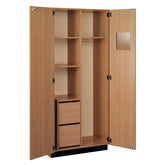How School Furniture Affects Student Learning
Styling your classroom is a fun and exciting way to prepare for a new school year, especially when you have the freedom to design it however you like for a specific theme. But did you know that the classroom furniture you choose is more than just for aesthetics?
From science classrooms to math classrooms, the furniture and layout you choose can have a positive impact on your student’s learning and engagement with the lessons. Modern classrooms are seeing a positive trend of ergonomic, flexible, and student-centered furniture designs that can promote student engagement and cater to various learning styles.
Shopping for furniture for your classroom but wondering which pieces would work best for your students? You have come to the right place. This post will review how different classroom furniture styles can impact student focus, engagement, and overall academic performance. Specifically, we will go over ergonomic and flexible furniture options and how they can promote collaboration and engagement while catering to various learning styles.
The Role of Ergonomics in Student Comfort and Focus
We’ve brought up the concept of ergonomic furniture pieces, but what does ergonomic mean and what does it have to do with teaching a class of students? Ergonomics refers to an element of design that focuses on improving the user’s comfort and efficiency. It means that ergonomic classroom furniture are pieces that are designed for student comfort while making working and learning as smooth as possible.
Ergonomics is important to keep in mind when choosing classroom furniture because it can help promote student learning and increase engagement with your lessons. Common school furniture pieces that can be ergonomic include student desks and chairs.
How Ergonomics Affect Learning
Furniture ergonomics connects physical comfort with cognitive focus. Have you ever sat in a hard plastic chair during a meeting and struggled to focus because your back was hurting? The same thing applies to your students. Poor seating options can lead to physical discomfort, which in turn leads to an inability to focus, an increase in distractions, and a decrease in academic performance.
This is not to say that comfort should be your only concern when shopping for school furniture. There needs to be a balance between comfort and practicality, as too much comfort can also increase distractions and decrease performance. Fitting your classroom with plush recliner chairs for each student is not going to promote learning, it will probably just lead to more classroom naps. Look for furniture that is comfortable for students and promotes productivity and efficiency.
Ergonomic Chairs & Desks
Now that we have hammered home the importance of ergonomics, what are some examples of classroom furniture that is comfortable and encourages student productivity? For desks, consider looking for ones that are height-adjustable and appropriate for your specific student age group. When shopping for chairs, look for ones that have good lumbar support and comfortable seats.
Promoting Collaboration with Flexible Furniture
Modern classrooms are seeing a gradual push towards flexible furniture pieces in classrooms instead of traditional desks with plastic chairs. Flexible furniture pieces are designed to allow students more freedom of movement while learning instead of the rigid plastic chair in front of a desk.
Why are we seeing more of these new flexible furniture styles in classrooms? Flexible seating not only improves student engagement and overall learning, but it also helps promote collaborative learning among your students.
Furniture and Collaborative Learning
The furniture and layout that you choose for your classroom can have a positive impact on student collaboration and engagement. When students are engaging with their peers, they are more excited about working together, and this in turn improves their learning.
Not only does collaboration in the classroom improve retention of lesson materials, but it can also teach them valuable life skills such as problem-solving, effective communication, and critical thinking. Students will take these skills with them outside of the classroom and use them throughout their lives, and giving them a safe space to develop them can help them out in the long run.
Modular Desks & Tables
Flexible furniture is not just limited to seating options, some desks and tables can support flexible group work and collaboration. Look for table options that are mobile and easy to move around, that way it is quick and easy to reconfigure your classroom for various activities and lesson plans.
The Versa Collection from Stevens ID Systems is a great example of flexible desk options for your classroom that are easy to move around and rearrange to meet your classroom needs.
Flexible Seating
Still not sure what flexible seating options would work for your classroom setup? Perhaps offering some examples will help kickstart the creative process. Try looking into soft seating options such as bean bags or floor cushions, as these can create more informal collaboration spaces for students that are not limited to them sitting in desk pods. Other options can include wobble stools, lap desks, and even balance balls.
Flexible seating consists of any seating option that is not the traditional 4-legged chair, so do not be afraid to think outside of the box.
Impact of Furniture on Student Engagement and Motivation
The furniture you choose does more than just improve productivity and academic performance. Your classroom furniture can also help to promote student engagement and motivation to learn. We all know that students will not learn anything if they do not want to, students have to be interested in learning for them to retain any of the material.
Creating a positive and engaging learning environment with your furniture pieces can get students excited to learn and improve their motivation to learn. The more that students engage with the lesson material, the better they will perform academically.
Color and Design in Furniture
The color and design of your classroom furniture are not just to make your classroom look pretty. Certain colors and designs can create a stimulating or calming environment for your students, and this in turn can impact your students' mood and energy levels throughout the day. Bright colors and lights can be stimulating and engaging for students, while softer colors and lights can make students feel more calm and relaxed in your classroom.
Different colors have different psychological effects on your students. For example, red is a very stimulating color that can make students feel energized and excited about learning. On the other end of the spectrum, colors like blue can have a calming effect and create a sense of trust between students and teachers.
Colorful School Furniture
Bright color schemes are not limited to the color of the walls. Choosing furniture pieces with vibrant and engaging colors can add to the aesthetic and energy of your classroom, and they can help stimulate student learning and engagement with the lesson.
However, do not just choose furniture with any bright color on it. Pick a color scheme and carry it throughout the classroom, as this will create a consistent theme and tie the room together.
Mobile storage options come in a wide variety of fun designs, and they can be that pop of color your classroom needs to get students engaged and excited about learning.
How Classroom Organization Affects Learning
When designing the layout of your classroom, an important thing to keep in mind is that you have enough storage space to hold all of your lesson materials. Proper storage and organization in the classroom can help you as the teacher keep your supplies organized and make preparing for lessons a smooth process overall.
In addition, a clutter-free space can also make students feel less cramped in the space and improve student engagement. Choosing furniture pieces with adequate storage can improve classroom productivity and academic performance.
The Importance of Decluttered Spaces
We mentioned it briefly earlier, but why exactly does an organized classroom improve student engagement and productivity? If you walk into a space that is filled with disorganized clutter and mess, how do you feel? Many people can start to feel stressed and overwhelmed by the environment, and your students can feel the same way.
A cluttered and disorganized classroom can not only make you and your students feel stressed or overwhelmed, but it can also lead to distractions and pull students away from the lesson. Both of these factors can hinder the learning process and decrease student productivity.
Classroom Storage Systems
Finding storage systems that will work for your classroom setup can be tricky at times, especially if you are working with limited space. While storage cabinets and closets are a fantastic resource for teachers, some classrooms are too small to fit a full filing cabinet or set of shelves.
In these instances, look for mobile storage bins and trays that can easily be moved around the classroom wherever they are needed. They can also be put away when they are not in use, saving you valuable classroom space. Another great option includes book storage solutions for your classroom library to make sure your books are organized and easily accessible to your students.
Personalized Storage for Students
On top of needing a space for classroom materials, students also need personal storage space where they can tuck away their individual belongings without the risk of them getting lost. Furniture pieces such as cubbies and lockers are a great way to give your students their own customizable storage space where all of their stuff can be stored in one spot and not get mixed up with other students.
Supporting Different Learning Styles With Diverse Furniture Options
Every student is different, and every student has a different way in which they learn and retain new information. Having diverse furniture options in your classroom can provide learning opportunities for students with any learning style, which makes your classroom more accessible to students and improves overall academic performance.
Adapting to Varied Learning Needs
Students have different learning needs that can set them up for academic success, and investing in various furniture to meet those needs can create a student-centered environment where students feel safe and comfortable learning.
Kids who need less stimuli to engage and learn may benefit from a quiet study corner where they can put on headphones and study in silence. If you have students with higher sensory needs, then sensory-friendly seating options can help them feel less overstimulated and therefore calmer in the classroom.
Flexible Learning Zones
If space allows it, a great option could be to create different learning zones in your classroom for students with different needs. For example, one corner of the classroom could be set up as a quiet reading corner where students can go and do silent reading. For more active learners, you could also create more active learning spaces with standing and collaborative desks or wobble stools.
Sensory-friendly furniture options are great for students who have specific sensory needs in the classroom. These can include padded chairs or wobble stools that allow students to fidget or rock while they learn, improving their concentration and safely meeting sensory-seeking needs.
Choosing the Best School Furniture for Student Learning
As educators, you want to create the optimal learning environment to set your students up for success. The right furniture can get your students excited about learning and improve their overall academic performance.
However, it is more than just choosing flexible seating and desk options, the right classroom storage system can create a more organized classroom environment and improve student engagement and learning. Investing in flexible, ergonomic, and student-centered furniture styles can help enhance student learning outcomes and overall academic success.
In the market for new classroom furniture? Stevens ID Systems has a downloadable catalog of all of our classroom furniture collections for you to choose from. Many of our pieces arrive pre-built, saving you the time and hassle of having to assemble furniture on your own. Browse today and find the perfect furniture for your classroom!
















